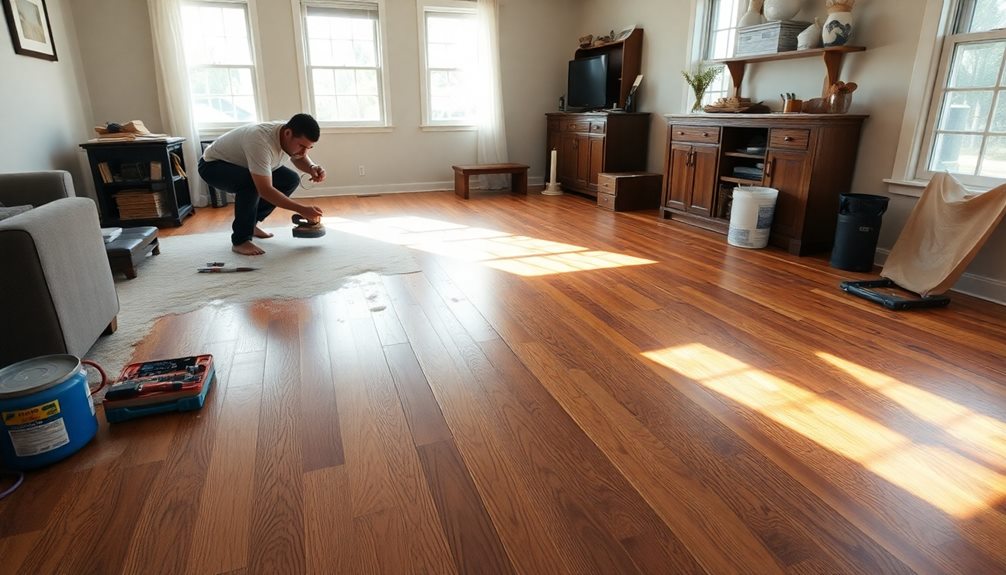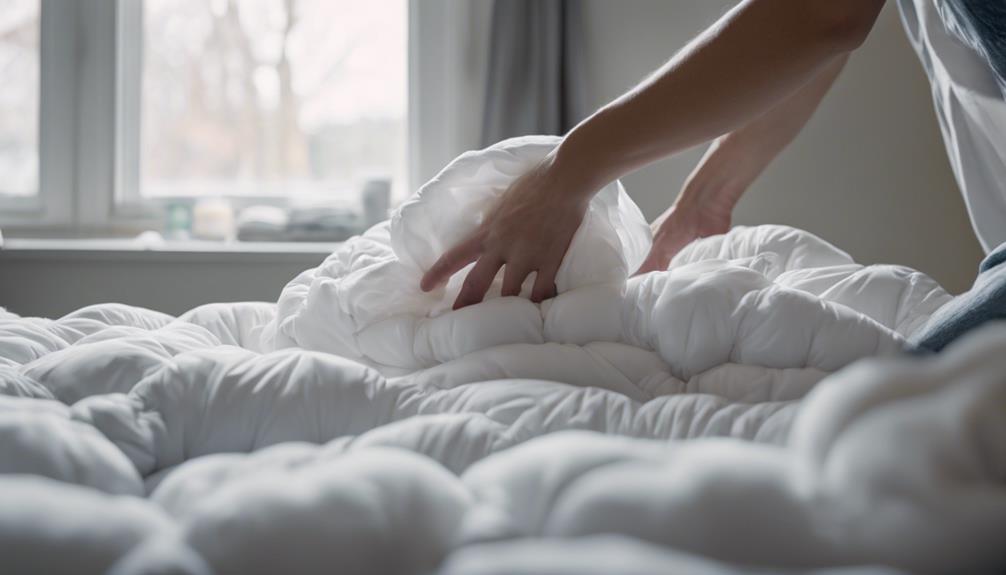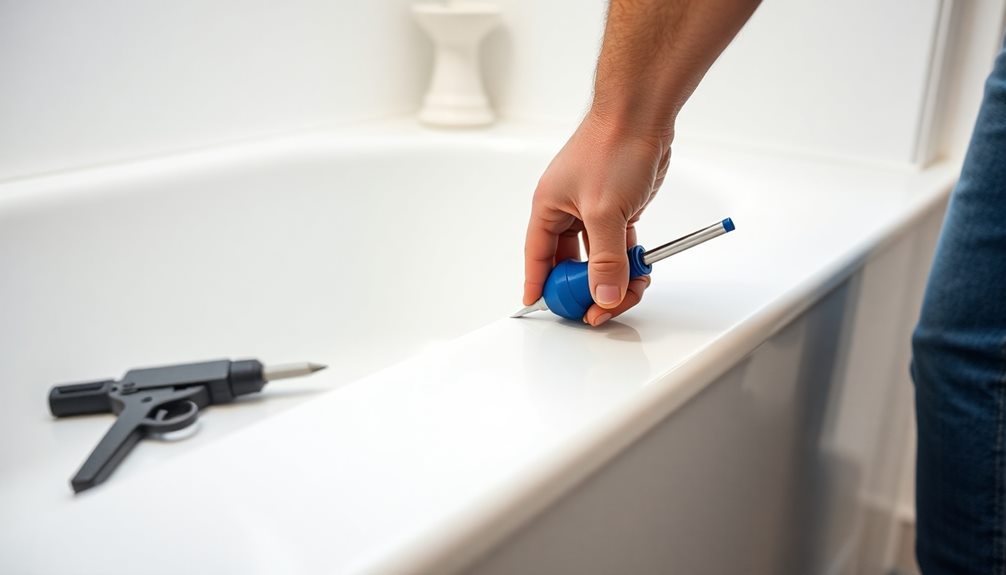Refinishing hardwood floors yourself can save you a significant amount compared to hiring professionals, often up to $1,500. You'll need essential tools like a drum sander, edge sander, and safety gear. Begin with proper prep work by cleaning the floors and sealing off the workspace. The process includes sanding, applying a protective finish, and allowing for drying time. It's vital to choose between water-based or oil-based finishes based on your preferences. With a bit of effort and right techniques, you can achieve a stunning result. There's plenty more to explore to guarantee your project goes smoothly.
Key Takeaways
- Refinishing hardwood floors as a DIY project can save you significant costs compared to hiring professionals or replacing the flooring entirely.
- Essential tools for the refinishing process include a drum sander, edge sander, vacuum, and safety gear to protect against dust.
- Proper surface preparation and cleaning are crucial for achieving a smooth and durable finish during the refinishing process.
- Choose between water-based or oil-based polyurethane finishes, each requiring different numbers of coats for optimal durability and appearance.
- Regular maintenance and timely refinishing every few years help extend the life and beauty of your hardwood floors.
Project Overview
Refinishing hardwood floors can be a rewarding DIY project that saves you money while revitalizing your living space. As a homeowner, tackling this project allows you to enhance the beauty and longevity of your floors without the hefty price tag of professional services.
Typically, you can complete the entire process in just one day, covering prep work, sanding, and applying finishes like polyurethane.
To get started, gather essential tools such as a drum sander, edge sander, vacuum, and safety equipment like a respirator. Renting larger equipment can be a budget-friendly option. A step-by-step guide will help you navigate the refinishing process efficiently.
Don't underestimate the significance of prep work. Clean your floors thoroughly and seal off the workspace to guarantee effective dust containment. This preparation is vital for achieving a smooth and durable finish.
Cost Comparison
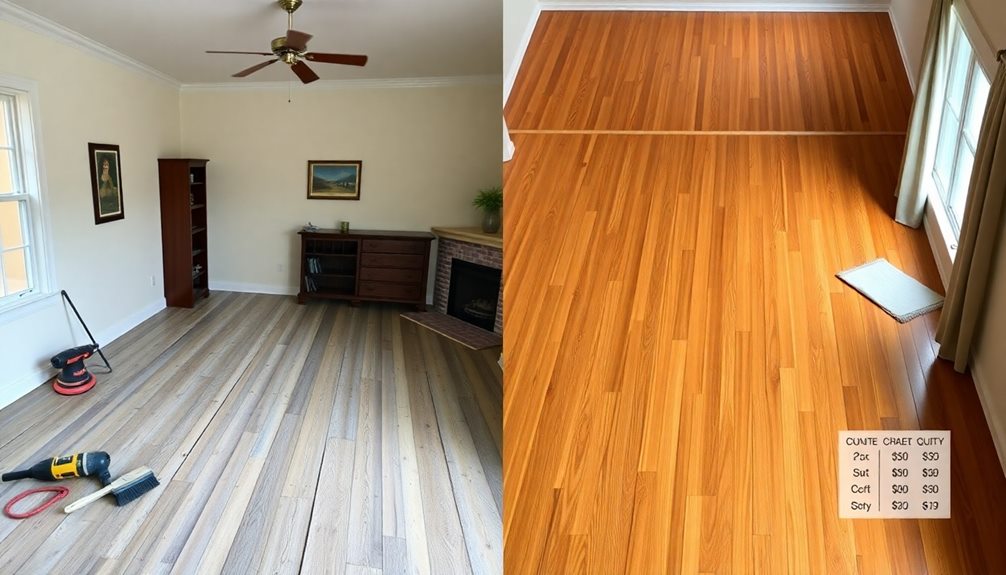
When considering the cost of hardwood floor refinishing, you'll find that tackling it yourself can save you a considerable amount of money. The average DIY refinishing cost typically ranges from $500 to $1,000, markedly lower than professional services, which can set you back anywhere from $1,100 to $2,663. Factors like square footage and finishing method influence your total costs.
Here's a quick cost comparison to visualize your options:
| Option | Cost Range |
|---|---|
| DIY Refinishing | $500 – $1,000 |
| Professional Services | $1,100 – $2,663 |
| Hardwood Floor Replacement | $2,475 – $7,031 |
| Renting Sanding Equipment (3 days) | $60 – $150 |
For a 700 sq. ft. area, your average DIY refinishing cost is around $1,000, or about $1.50 per square foot. While renting sanding equipment adds to your overall DIY costs, careful planning can help you maximize saving money. Ultimately, choosing DIY refinishing could be a smart financial decision for your hardwood floors.
Refinishing vs. Replacement
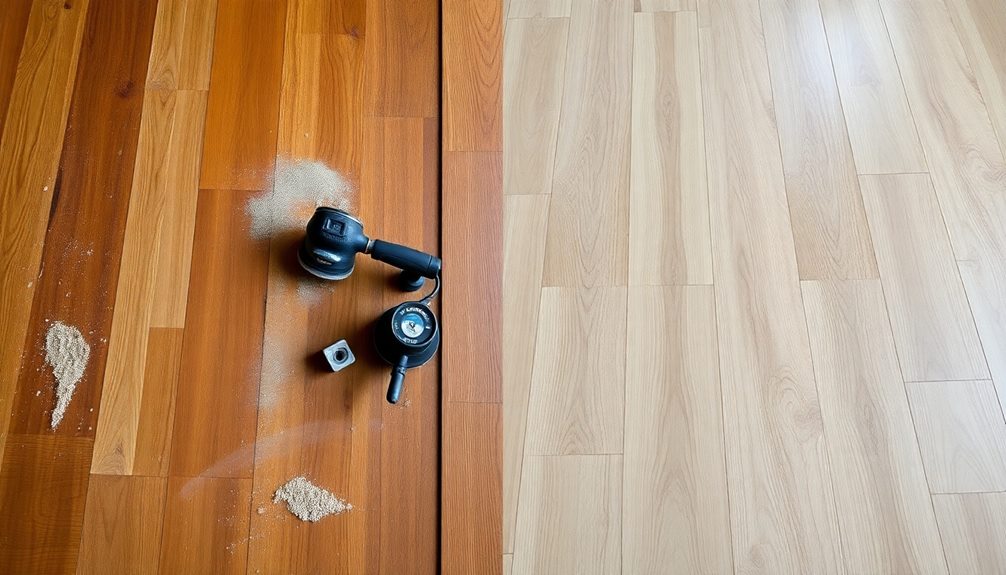
When you're faced with the choice between refinishing and replacement, cost and long-term benefits are key factors.
Refinishing your hardwood floors typically saves you a significant amount compared to the expense of replacing them entirely.
Plus, refinishing can extend the life of your existing floors, making it a smart investment for your home.
Cost Comparison
Choosing between refinishing and replacement can be a challenging decision, especially when considering the financial implications. A cost comparison reveals that refinishing hardwood floors is generally a more economical option than replacing them entirely.
Here's a breakdown of the costs you might encounter:
- DIY Refinishing: Typically between $500 and $1,000, depending on your materials and tools.
- Professional Refinishing: Ranges from $1,100 to $2,663 for expert service.
- New Hardwood Installation: Costs can skyrocket from $2,475 to $7,031, which includes both materials and labor.
- Materials Cost: Flooring materials vary from $6 to $25 per square foot, adding considerably to replacement expenses.
When you refinish your hardwood floors, the cost per square foot is often around $1.50, making it a budget-friendly alternative to the higher costs of professional installation or replacement.
Long-Term Benefits
Refinishing hardwood floors not only proves to be a more cost-effective choice compared to replacement, but it also offers significant long-term benefits that enhance both your home's aesthetics and value.
When you choose to refinish hardwood floors, you're investing in a solution that can extend the life of your flooring by several years. This means you can maintain your investment without facing the hefty costs associated with replacing hardwood flooring, which can range from $2,475 to $7,031.
The refinishing process revitalizes worn floors, enhancing their appearance and ultimately increasing the value of your home. Unlike replacement, which may not always guarantee a return on investment, refinishing can yield a more attractive outcome at a fraction of the cost—typically between $500 and $1,000 for DIY projects.
Additionally, regular refinishing every few years based on wear allows you to keep your floors looking fresh without committing to a permanent solution.
Incorporating a DIY approach can further reduce expenses while reaping these long-term benefits. By choosing to refinish rather than replace, you ascertain your hardwood flooring remains a beautiful and valuable asset in your home.
Considerations Before Refinishing
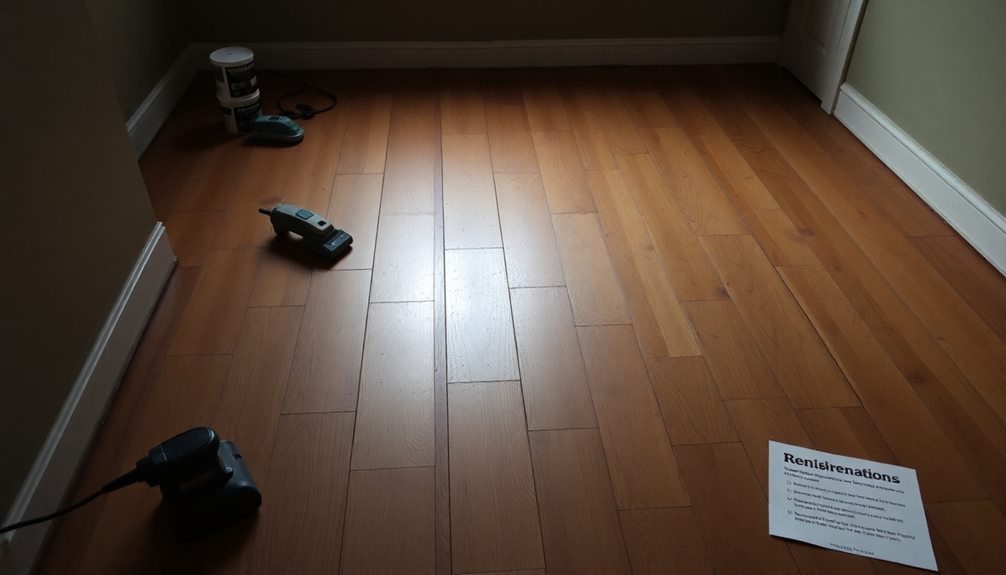
Before diving into the refinishing process, it's crucial to assess the condition of your hardwood floor.
You'll want to thoroughly inspect for any damage, as visible wear may necessitate sanding before refinishing.
Consider the following factors before you begin:
- Damage Assessment: Look for deep scratches, dents, or discoloration. If the damage is severe, full sanding may be required.
- Water Damage: Be cautious of water damage. Some wood types have tannins that can react with water-based polyurethane, leading to discoloration.
- Base Coat Application: To mitigate potential discoloration, consider applying a base coat. Allow it to dry for about two hours before proceeding.
- Maintenance Schedule: Regular maintenance and timely refinishing are key. Depending on wear, a refinishing schedule is typically recommended every few years.
Recommended Tools and Steps
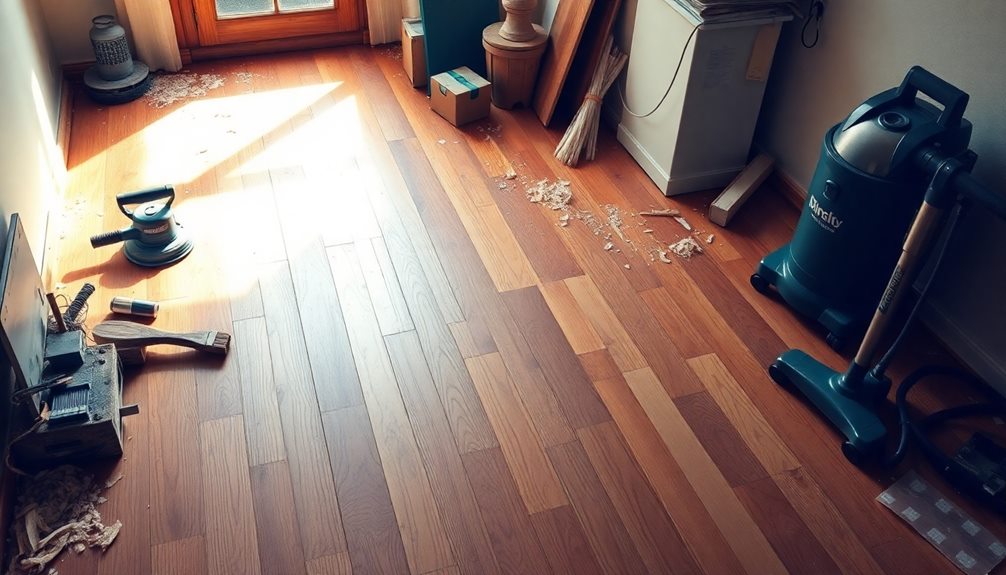
What tools do you need to successfully refinish hardwood floors? First, you'll require a floor sander and an edge sander to tackle both large areas and corners.
Don't forget coarse sandpaper, starting with 36-grit for heavy sanding, then moving to 60-grit and finally 100-grit for a smooth finish. A vacuum is essential for cleaning the floor after sanding, and a microfiber flat mop will help with the final clean.
Safety gear is a must—wear a respirator to protect yourself from dust. Before you start sanding, make sure to remove all furniture and base moulding to prepare your workspace.
Once the sanding is done, apply a protective wood finish, like oil-based polyurethane, using a lambs wool applicator. Lightly sand between coats with fine grit sandpaper for a uniform finish, and allow at least 24 hours of drying time between each coat.
Sanding Process Techniques
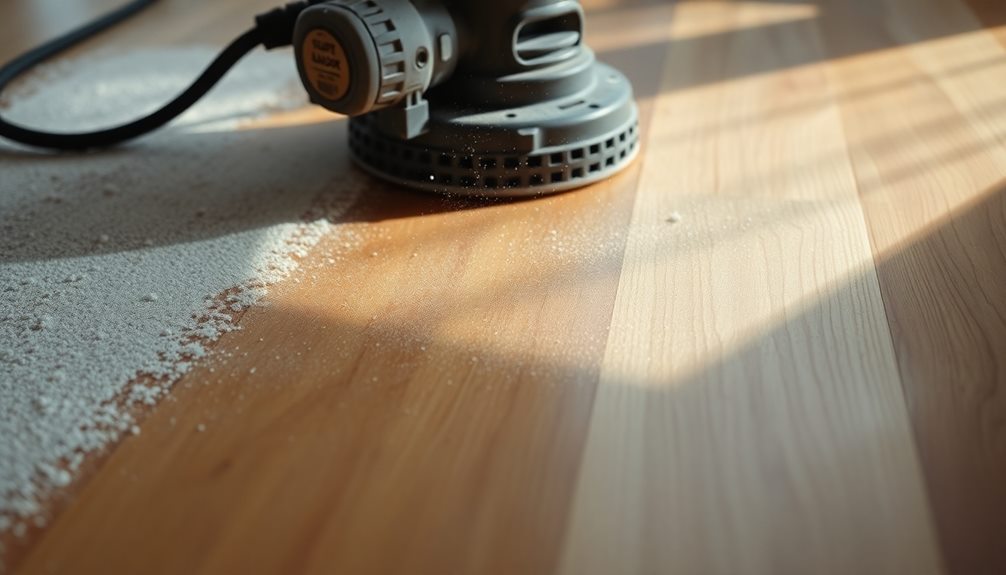
Once you've gathered your tools and prepared your workspace, it's time to focus on the sanding process. This stage is essential for achieving a smooth, uniform surface on your hardwood floors. Here's how to tackle it effectively:
- Start with coarse grit sandpaper (36-40 grit): Use a drum sander to remove old finishes and imperfections by sanding along the direction of the floorboards.
- Progress to medium grit (60 grit): After the initial sanding, switch to medium grit to refine the surface further. Remember to replace sandpaper regularly—about every 250 square feet.
- Finish with fine grit (100 grit): This step will give your floors that final smooth touch.
- Edge sanding: Don't forget the edges! Use a floor edger or small orbital sander with coarse-grit paper first, then shift to finer grades.
Throughout the sanding process, make sure to regularly clean the floor by sweeping and vacuuming to remove dust and debris.
Maintaining consistent pressure and pace while sanding helps prevent uneven spots, ensuring a beautiful finish on your hardwood floors.
Finishing Techniques
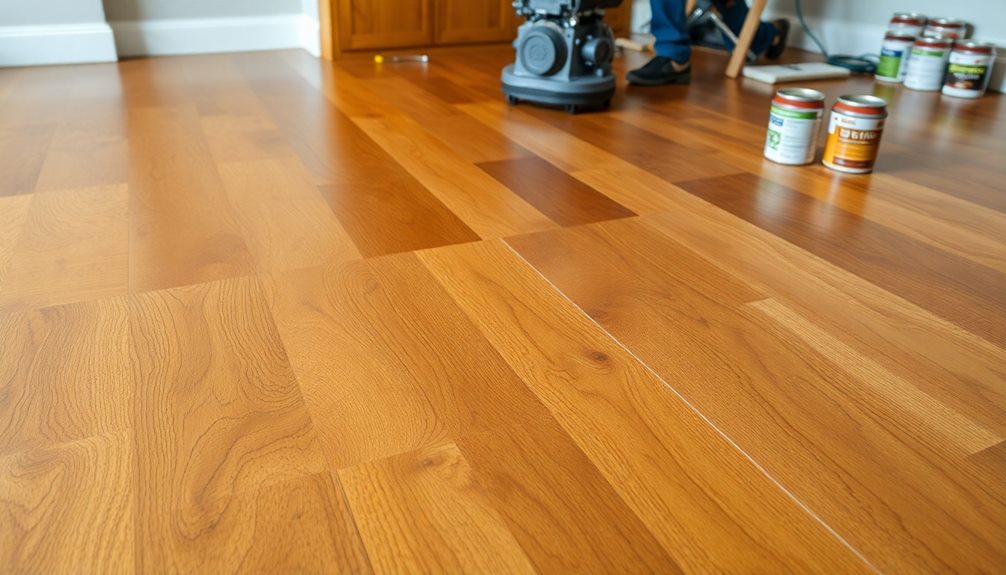
Achieving a flawless finish on your hardwood floors is essential for both aesthetics and durability. When you're ready to apply a wood finish, you can choose between water-based or oil-based polyurethane. Water-based finishes typically need four coats for maximum durability, while oil-based finishes require three.
Before you start, make certain to clean the surface thoroughly to avoid dust particles that can trap and create a rough texture. Use 220-grit sandpaper or #000 steel wool to lightly sand the surface between coats. This step improves adhesion for the subsequent layers and guarantees a smooth finish.
For an even application, a lambs wool applicator works wonders. Apply the finish in manageable sections to maintain a wet edge, preventing unsightly lines or uneven spots.
Don't forget about drying time: water-based finishes usually require about 24 hours, while oil-based finishes may need longer. Here's a quick reference table to help you:
| Finish Type | Coats Required | Drying Time |
|---|---|---|
| Water-Based | 4 | 24 hours |
| Oil-Based | 3 | 48 hours or more |
Frequently Asked Questions
Can I Refinish My Hardwood Floors Myself?
Yes, you can refinish your hardwood floors yourself! It involves renting the right tools, preparing the surface carefully, and following the sanding and finishing steps. With patience and effort, you'll achieve beautiful results.
How to Make Old Hardwood Floors Look Better Without Refinishing?
Can you imagine transforming those tired floors without the hassle of refinishing? Regular cleaning, applying polish, using area rugs, touching up scratches, and maintaining humidity can all breathe new life into your hardwood floors effortlessly.
Can Wood Floors Be Refinished Without Sanding?
Yes, you can refinish wood floors without sanding. By screening, you lightly abrade the surface, remove the old finish, and prepare it for a new coat, giving your floors a refreshed look without the hassle.
Is It Cheaper to Sand and Refinish Hardwood Floors or Replace Them?
It's definitely cheaper to sand and refinish hardwood floors than to replace them. Refinishing typically costs around $1.50 per square foot, while replacement can range from $6 to $25 per square foot. You'll save considerably!
Conclusion
In summary, tackling hardwood floor refinishing yourself can save you money and give your space a fresh look. For instance, when Sarah refinished her living room floors, she spent just $300 on supplies instead of the $1,500 quote from a professional. With the right tools and techniques, you can achieve stunning results and enjoy the satisfaction of a job well done. So roll up your sleeves, and transform your hardwood floors into a beautiful centerpiece of your home!
